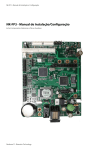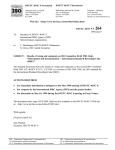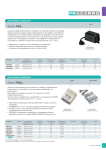Download Microprocessors Lab Manual
Transcript
Microprocessors Lab Manual
6: Introduction to 586 Engine and PIO
1-Introduction
The objectives of this lab are:A- To get the students familiar with the SC-586 microprocessor developing board.
B- To teach the students how to program a general input/output (GPIO), and how to write/
read the digital signals.
2-Theory
586 Engine is a high performance 32-bit 586 CPU with Floating Point Unit (FPU), ADC,
DAC, UARTs, with the following specifications:
•
•
•
•
•
•
•
•
•
•
•
•
•
•
•
•
Measures 3.6x2.3x0.3 inches
32-bit CPU (AMD SC520), x86 compatible
100/133 MHz system clock
High performance hardware floating point coprocessor
Power consumption: 440 mA at 5V
Temperature: -40 to +80 Celsius
Up to 512 KB Flash/EPROM
Up to 512 KB battery-backed SRAM
114 byte internal RAM
32 PIOs
7 timers
15 interrupts
One synchronous serial-port, three UARTs
19 channels 12-bit ADC
8 channels 12-bit DAC
Real-time lock, battery
The 586-Engine (TM) (5E) is a C/C++ programmable controller based on a 32-bit 100/133
MHz AMD Elan SC520. The SC520 integrates an Am586 CPU and a high performance
ANSI/IEEE 754 compliant 64-bit hardware floating point unit (FPU). It is designed for embedded
systems that require high performance, PC-compatibility, compactness, and high reliability at a low
cost. Whether you use it as the processor core component of an OEM product, as part of a smart
sensor, or as a node in a distributed microprocessor system, building your product around the 5E
will reduce development time and costs, minimize technical risks, and allow you to deliver a more
reliable end product.
The FPU provides arithmetic instructions to handle numeric data and transcendental functions for
sine, tangent, logarithms, etc, making this controller useful for intensive computational applications.
It is estimated to be 10-50 times faster than software-emulate on an 8/16-bit controller without a
FPU.
35
Microprocessors Lab Manual
The 586-Engine supports up to 15 external interrupts. There are a total of seven timers, including
one programmable interval timer (PIT) that provides three 16-bit PIT timers and three 16-bit GP
timers, plus a software timer. These timers can support timing or counting external events. The
software timer provides a very efficient hardware time base with microsecond resolution. A realtime clock (RTC) provides time-of-day, 100-year calendar and 114 bytes of battery backed RAM.
Two industrial-standard 16550-compatible UARTs support baud rates up to 1.152 M baud. One
synchronous serial interface (SSI) supports full-duplex bi-directional communication. One
additional optional UART (SCC2691) can be installed.
The 586-Engine(TM) boots from on-board 256K 16-bit ACTF Flash, and supports up to 256K 16bit battery-backed SRAM. SDRAM and DMA are not supported. Up to 1GB memory expansion
can be added with MemCard-A and PCMCIA ATA Flash cards.
There are 32 programmable multifunctional I/O lines (PIO) that can be used as general I/O or other
functions. Two supervisor chips monitor 5V and 3.3V and provide power failure detection,
watchdog and system reset. The 2.5V is used for the SC520 core and 3.3V for the I/O operation.
Signal lines on headers are 3.3V output, and 5V maximum input.
All components are soldered on board for highest reliability. The 586-Engine^(TM) can be powered
with a single regulated 5V with the on-board 3.3V and 2.5V regulators. It also can be powered by
external regulated 5V, 3.3V, and 2.5V.
A total of 19 analog inputs are supported with a serial ADC (TLC2543, 11 inputs, 20KHz sample
rate, 12-bit, 0-REF+) and a parallel ADC (AD7852, 8 inputs, 100KHz sample rate, 12-bit, 0-5V).
Two serial DACs (LTC1446, 2 channels, 0-4.095V) and a parallel 12-bit DAC (DA7625, 4
channels, 0-2.5V) can be in-stalled to provide a total of 8 analog outputs.
The 586-Engine shares a similar pin-out and physical dimensions with the i386-Engine, A-Engine
and V25-Engine-LM. As compared to these other engine-based controllers, the 5E offers
substantially more computing power at greater per-unit costs and power requirements.
The EZ-586 Tutor PIO pins are 3.3V output and all inputs are 5V tolerate. Absolutely
no voltage above the 5 volt should be applied to any pins. Over 5 volt
can cause a permanent damage. Pins P0-P1, P27, and P31 are free to use. A P10 line
can be configured to operate as an output or an input with a weak internal pull-up resistor.
Paradigm C++ is a complete Integrated Development Environment (IDE) for developing
real and protected mode x86 embedded system applications. The integrated source level debugger
for all the Intel 186 and 386 microprocessors supports stand-alone debugging or can be used as a
front-end for popular in-circuit emulators from Applied Microsystems and others. Paradigm C++
shares a common user interface with full support for source level debugging of embedded C/C++
applications. Featuring watches, inspectors, and a variety of memory, I/O and real-time operating
system viewers, Paradigm C++ provides a high level of control and visibility of the target system.
When necessary, the ability to drop down to a low level CPU or memory view is always available.
Paradigm C++ includes the Paradigm PDREMOTE/ROM debugging kernel, ready to be customized
for your unique target system. Customized versions of Paradigm C++ add support for hardware
breakpoints, real-time trace, overlay memory, and other custom hardware found in popular incircuit emulators.
36
Microprocessors Lab Manual
3. Equipment Used
¾
EZ-586 Tutor from AMS that contains a 586 (5E) controller from Tern. (Note
that PIO 6, 7, 8, and 9 are not working).
¾
¾
¾
¾
Paradigm C/C++ Software
Digital training kit ETS-7000.
Oscilloscope.
Logic analyzer.
4. Procedures
1- Demonstrating the hardware and software.
1.1 Connect the DB9 connector from COM1 or COM2 of the PC’s ports to J3 on EZ-586
Tutor. LD3 turn on indicating that the selected PC’s COM port is active.
1.2 Make sure SW1 (all switches are set to off position) on the EZ-586 Tutor.
1.3 Make sure that the step 2 Jumper is connected to J1(pins 38-40) on the tutor in order to
enable you to download the written program from the PC to the EZ tutor.
1.4 Connect the wall transformer (+9VDC) to J1 of the EZ-586 Tutor. LD1 turn on
indicating that the board is powered up. LD2 and LD5 also turn on. Here look at L1 at the 586
engine it will blink twice then stays on, this indicate that the board is ready to download programs.
1.5. Open the Paradigm C/C++ software and if there is any existing project Æ Click on
Project Æ Close project, then Click on Project Æ Open project Æ Browse the project:
C:\Tern\586\led.ide and click OK. [Note that the directory (C:\ or D :\) will depend on your
installation.]
37
Microprocessors Lab Manual
1.6 You can see the following screen:
1.7. Power On the 586 board, Build the project by pressing F9 or Click Project Æ Make
All. Then, Double Click on the led.axe and it will download led.axe to the Tern 586 board.
38
Microprocessors Lab Manual
This is the download page;
And this is the program,
/*********************************************************************
led.c
Test LED on 586-Engine
10-13-2000
Turn LED on and off with PIO 0
*********************************************************************/
#include "586.h"
/* 586 initialization */
unsigned char ledd;
unsigned int i,k;
void main(void)
{
sc_init(); // 586
ledd=0;
k=30000;
39
Microprocessors Lab Manual
while (1){
led(ledd); // Directive led(0,1)
ledd = ~ledd; // ~ --->> complement
for(i=0;i<k;i++)
{
ledd=ledd; // wasting time or delay
}
delay_ms1(10); // or you can use delay_ms(1000)
}
}
1.8. After Downloading is completed, the Debug Window will appear. And Click on View
Æ then select Target Peripherals you wish to view. Then you can debug as usual like Single
stepping, Setting breakpoint
40
Microprocessors Lab Manual
2- Building GPIO project.
2.1 Repeat all the above procedures.
2.2 Copy and past the project led.ide to a LAB1-gio.ide, LAB1-demo, and LAB1-input.
3- Open the lab1-demo.ide project again after closing all the opened projects, then try to
delete the program “led.c” and load instate of it “ 586_pio.c”, then save the project
4- Connect J2 with a 40 pins flat IDE cable to the ETS-7000 Digital training kit via the
60 pin adapter.
5- Check the data sheet for J2 connection.
6- The program 586_pio.c is as follow;
//*******************************************************************
//
586_pio.c
10-13-2000
//
SC520 has 32 Programmable I/O pins: PIO 0-31
//
Each can be programmed as a PIO function or "Interface" function.
//
See SC520 User's Manual(on the CD) Table 23-1 for details
//
sc_init(); initialize after power on, as:
//
P27=/GPCS0=J2.37 for 16-bit I/O operation of on-board ADC/DAC
//
P31=J2.38 as input for STEP2 jumper reading
//
P0 as output for on-board LED control
//
P1=/GPBHE=J1.11 as /BHE for 16-bit data bus high byte enable signal
//
Other 28 PIO pins on the J2 header are free to use:
//
PIO 2-26 and PIO 28,29,30
//
//
Functions for port I/O pins:
// void pio_init(char bit, char mode)
//
where bit=0-31
//
mode=0, Interface operation
//
mode=1, Input with pullup/down
//
mode=2, Output
//
//
void pio_wr(char bit, char dat)
//
where bit=0-31
address the PIO 0-31 pins
//
dat=0/1 controls voltage low/high
//
// unsigned int pio_rd(char port)
//
return status on PIO 15-PIO 0, if port=0
//
return status on PIO 16-PIO 31, if port=1
//
// You can also direct write 16-bit to the PIO register as below:
//
poke(MMCR, _PIOSET15_0_, m); to set PIO 15-0 output pins high
// poke(MMCR, _PIOCLR15_0_, m); to set PIO 15-0 output pins low
41
Microprocessors Lab Manual
//
poke(MMCR, _PIOSET31_16_, m); to set PIO 31-16 output pins high
// poke(MMCR, _PIOCLR31_16_, m); to set PIO 31-16 output pins low
//*******************************************************************
#include
"586.h"
/* 586E initialization */
unsigned char i, ledd;
void main(void)
{
sc_init();
/* 586E initialization */
//
Setup PIO 0=LED, PIO 2-26 and PIO 28,29,30 as output
pio_init(0, 2); // PIO 0=LED as output
for(i=2;i<27;i++){
pio_init(i, 2); // PIO 2-26 as output
}
pio_init(28, 2); // PIO 28 as output
pio_init(29, 2); // PIO 29 as output
pio_init(30, 2); // PIO 30 as output
ledd=0;
while(1)
{
pio_wr(0,ledd);
// led on main board PIO 0
for(i=2;i<27;i++){
pio_wr(i, ledd); // PIO 2-26 as output
}
pio_wr(28,ledd);
// P28
pio_wr(29,ledd);
// P29
pio_wr(30,ledd);
// P30
pio_wr(2,ledd);
// P2---->>> Relay
ledd=~ledd;
delay_ms(1000);
}
}
Compile the project, built, then run the project.
2.4 Check all the pins from P2-P27, P29, and P30 on the training board then on the logic
analyzer.
2.5 Update the above C program to generate a 3 second ON then 3 second OFF flashing
patterns using P4 till P7 that must connected to board’s LEDs or the logic analyzer and
oscilloscope. Here repeat the delay statement seven times to get a square wave of 6.120
second period.
42
Microprocessors Lab Manual
2.6 Write a program that generates 20 ms square wave using P10 and show your output on
the oscilloscope.
2.7 Connect P10, P11 to LEDs on the training board or your logic analyzer and P12, P13 to
the switched, and then develop a program that reads from the input switch and displays
on the LEDs. The inputting program as follow:#include "586.h"
/* 586E initialization */
unsigned integer a,b;
void main(void)
{
sc_init ();
/* 586E initialization */
pio_init(12, 2); // Pin 12 as output
pio_init(10, 1); // Pin 10 as input
pio_init(13, 2); // Pin 13 as output
pio_init(11, 1); // Pin 11 as input
while (1) {
a = pio_rd(0); // read from 0-15 the lower sixteen
if (a&0x0400) pio_wr(12,1);
else pio_wr(12,0);
if (a&0800) pio_wr(13,1);
else pio_wr(13,0);
}
}
5. Questions
Do all the procedures steps very carefully and show all your results to the instructor.
43
Microprocessors Lab Manual
6. Appendixes
1.
2.
3.
4.
www.advancedmsinc.com
www.tern.com
www.testech-elect.com/tern
http://www.edaboard.com/forums.html
5.
Delay
(Counts)
25
50
100
200
300
400
500
600
800
1000
Time
(ms)
20
40
80
160
240
320
400
480
640
800
Frequency
(Hz)
50
24
12
6
4.2
3.12
2.5
2
1.5
1.25
44
Microprocessors Lab Manual
586 Functional Description
Measuring 3.6 x 2.3 x 0.3 inches, the 586-Engine(5E) is a C/C++ programmable microprocessor
module based on a 100/133 MHz, 32-bit CPU (ElanSC520, AMD). Features such as its low cost,
compact size, surface-mount flash, high performance floating point coprocessor, and reliability
make the 5E ideal for industrial process control and applications requiring intensive mathematical
computation. It is designed for embedded applications that require compactness and high reliability.
The 586-Engine (5E) integrates an Am586 CPU and high performance ANSI/IEEE 754 compliant
hardware floating point unit (FPU). It provides arithmetic instructions to handle various numeric
data types and formats and transcendental functions for sine, cosine, tangent, logarithms, etc, useful
for intensive computational applications.
Special Note: The core of the Am520 CPU operates at +2.5V and the I/O operation at +3.3V. Also,
the input for the I/O is +5V compatible. Stresses above these can cause permanent damage to the
SC520 CPU. Operation above these values is not recommended, and can effect device reliability.
Functional block diagram of the 586-Engine
The 586-Engine boots up from on-board 512KB ACTF Flash, and supports up to 512KB batterybacked SRAM. No SDRAM, PCI, or DMA supported. The on-board Flash has a protected boot
45
Microprocessors Lab Manual
loader and can be easily programmed in the field via serial link. Users can download a kernel into
the Flash for remote debugging. With the DV and ACTF Flash Kit support, user application codes
can be easily field programmed into and run out of the Flash.
A real-time clock* (RTC72423) provides information on the year, month, date, hour, minute, and
second, in addition to a 100-year calender and 114 bytes of general purpose battery-backed RAM.
This RAM is used by the real-time clock, as well as the ACTF to store the jump address as the
pointer to the users application code.
Two industy-standard UARTs support high-speed, reliable serial communication at a rate of up to
1.152 M baud via RS-232 drivers. One synchronous serial interface (SSI) supports full-duplex bidirectional communication. An optional UART SCC2691 may be added in order to have a third
UART on-board. All three serial ports support 8-bit and 9-bit communication.
There is one programmable interval timer (PIT) providing 3 16-bit PIT timers and 3 16-bit GP
timers, and a software timer. The timers support timing or counting external events. The software
timer provides a very efficient hardware timebase with microsecond resolution. In addition, there
are two supervisor chips that monitor for power failure, watchdog and system reset.
The 586-Engine provides 32 user-programmable, multifunctional I/O pins from the CPU. Most of
the PIO lines share pins with other functions. The 586E supports up to 15 external interrupts. No
repair support is available for the 388 pin BGA SC520.
A high-speed, up to 300K samples per second, 8-channel, 12-bit parallel ADC* (AD7852) can be
installed. This ADC includes sample-and-hold and precision internal reference, and has an input
range of 0-5 V. The 586-Engine also supports a 4-channel, high-speed parallel DAC* (DA7625, 02.5V).
An optional 12-bit serial ADC (P2543) has 11 channels of analog inputs with sample-and-hold and
a 5V reference that facilitate ratiometric conversion, scaling, and isolation of analog circuitry from
logic and supply noise, supporting conversion up to a sample rate of approximately 10 KHz. Up to
two optional 2-channel, 12-bit serial DAC (LT1446) that provides 0-4.095V analog voltage outputs
capable of sinking or sourcing 5mA is also available. Overall the 5E can support up to 8 analog
outputs and 19 analog inputs.
1.2 Features
• Dimensions: 3.6 x 2.3 x 0.3 inches
• Temperature:-40°C to +80°C
• 133MHz, 32-bit CPU (ElanSC520, AMD), Intel 80x86 compatible
• Easy to program in C/C++
• Power consumption: 440 mA at 5V
• Power input: +5V regulated DC, or + 9V to +12V unregulated DC with P100 expansion board
installed*
• 512 KB SRAM, 512 KB, 114 byte internal RAM
• 8-channel 300 KHz parallel 12-bit ADC (AD7852) with 0-5V analog input*
• 4-channel 200 KHz parallel 12-bit DAC (DA7625) with 0-2.5V analog output*
• 2 channels serial 12-bit DAC (LT1446), 10 KHz *
• 11 channels serial 12-bit ADC (P2543), 10 KHz *
• high performance floating point coprocessor
• Up to 1GB memory expansion via MemCard-A
• Up to 3 serial ports (2 from ElanSC520, plus one optional SCC2691 UART) support 8-bit or 9-bit
asynchronous communication *
46
Microprocessors Lab Manual
• 15 external interrupts with programmable priority
• 32 multifunctional I/O lines from ElanSC520, 1 SSI, 7 16-bit timers
• 114 bytes internal battery-backed RAM. Supervisor (691) for power failure, reset and
watchdog
• Real-time clock (RTC72423), lithium coin battery*
• P100 I/O expansion board for regulated 5V power, RS-232/485 drivers, and TTL I/O lines
optional
Physical Description
The physical layout of the 586-Engine is shown below
Physical layout of the 586-Engine
SC520 PIOs
The SC520 supports 32 user-programmable I/O lines (PIO). Each of these pins can be used as a user
programmable input or output signal, if the interface function is not needed.
The 586-Engine PIO pins are 3.3V output and all inputs are 5V tolerant. Absolutely no voltage
greater than 5V should be applied to any pins. Over 5V voltage input can cause permanent damage.
After power-on/reset, PIO pins default to various configurations. The initialization routine,
sc_init();, provided by TERN libraries reconfigures some of these pins as needed as:
P27=/GPCS0=J2.37 for 16-bit I/O operation of on-board ADC/DAC
P31=J2.38 as input for STEP2 jumper reading
P0 as output for on-board LED control
P1=/GPBHE=J1.11 as /BHE for 16-bit data bus high byte enable signal
Other 28 PIO pins on the J2 header are free to use. PIO 2-26 and PIO 28, 29, 30 A PIO line can be
configured to operate as a output or an input with a weak internal pull-up or pull-down resistor. A
PIO pin’s behavior, either pull-up or pull-down, is pre-determined and shown in the table below.
47
Microprocessors Lab Manual
These configurations, as well as the processor-internal peripheral usage configurations, are listed
below in next Table.
I/O pin default configuration after power-on or reset
C function in the library 586.lib can be used to initialize and to operate PIO pins.
void pio_init(char bit, char mode);
Where bit = 0-31 and mode = 0 (for interface function), 1 (for input), or 2 (for output).
Example: pio_init(31, 2); will set P31 as output
pio_init(1, 0); will set P1 as /GPBHE
48
Microprocessors Lab Manual
void pio_wr(char bit, char dat);
pio_wr(31,1); set P31 pin high and the LED is off, if P31 is in output mode
pio_wr(31,0); set P31 pin low and the LED is on, if P31 is in output mode
unsigned int pio_rd(char port);
pio_rd (0); return 16-bit status of P0-P15, if corresponding pin is in input mode,
pio_rd (1); return 16-bit status of P16-P31, if corresponding pin is in input mode,
Some of the I/O lines are used by the 586-Engine system for on-board components (Table 3.2). We
suggest that you not use these lines unless you are sure that you are not interfering with the
operation of
such components (i.e., if the component is not installed).
49
Microprocessors Lab Manual
50
Microprocessors Lab Manual
51

















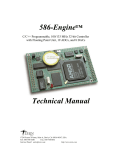


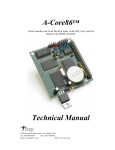
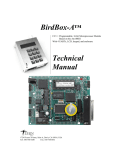



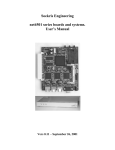
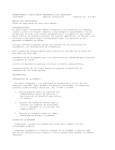

![E^YB?= ce``_bd VY\Uc V_b @QbQTYW] 4UReW BD](http://vs1.manualzilla.com/store/data/005839928_1-81490c34e940fa2480ecad1c81f1b8b0-150x150.png)



